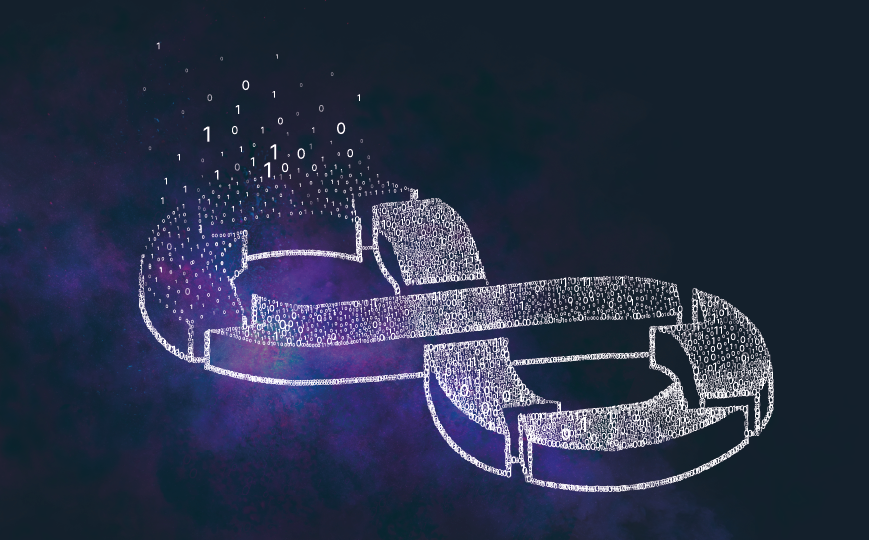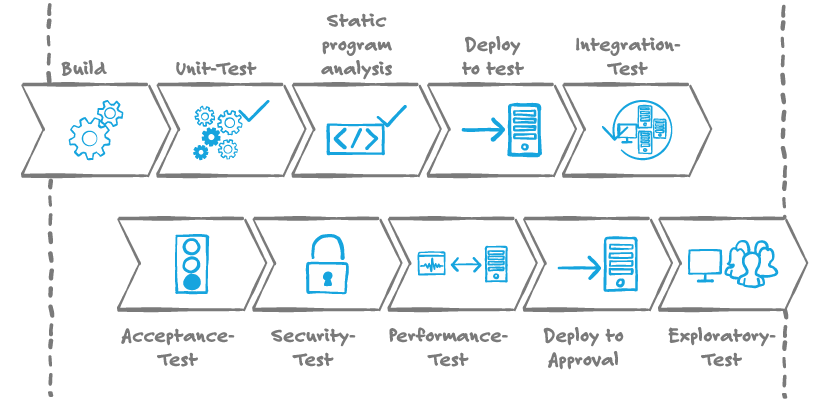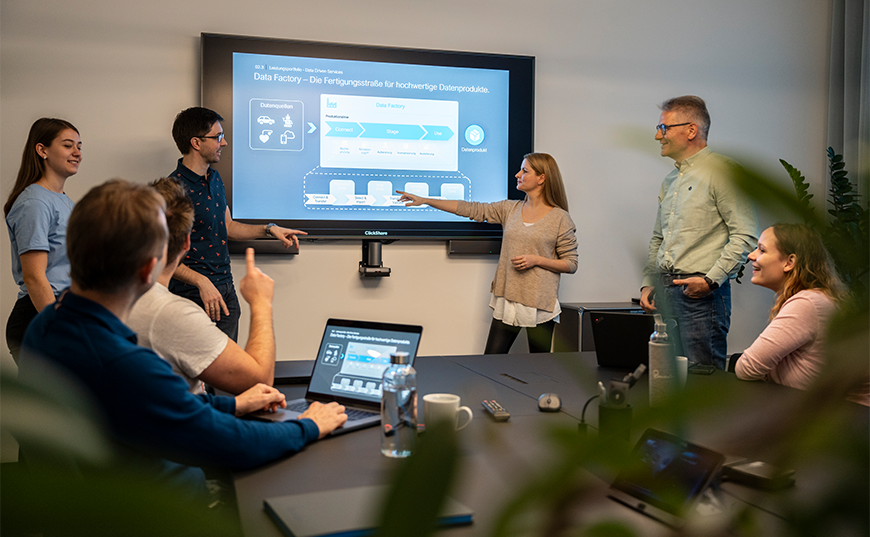
Continuous Delivery
Equipped to Keep Up with Digitalization Through Continuous Delivery
Unternehmen, die die Bedürfnisse ihrer Kunden schneller und genauer abdecken als der Wettbewerb, haben einen entscheidenden Vorteil. Die Dynamik, mit der sich Märkte und Bedürfnisse verändern, muss sich auch in der Softwareentwicklung spiegeln. Zu den besonders effizienten Entwicklungsmethoden, die in das schnelllebige Umfeld der Digitalisierung passen, gehören Continuous Integration, Delivery und Deployment. Continuous Delivery unterstützt Unternehmen dabei, agile Softwareentwicklung konsequent über den gesamten Prozess hinweg umzusetzen. Mit Continuous Delivery automatisieren Sie Ihre Infrastrukturen und Deployments und sind somit in der Lage, agile Softwareprojekte kostengünstiger und effizienter abzuwickeln.
The fast-paced world of digitalization often presents challenges for software projects:
- Business processes are increasingly dependent on software. Economic damage occurs when software applications do not function reliably.
- Software in the corporate environment is becoming increasingly complex
- New competition is emerging from globalisation and other industries. This is why it’s important to shorten time-to-market and be able to react quickly to changes.
- Manual processes are more expensive than automated ones and need to be gradually eliminated in order to remain competitive in the context of digital transformation.
It is imperative for companies to address the topic of continuous delivery in the near future to ensure their survival in the evolving market.
Leading corporations such as Google and Amazon, along with prominent German businesses like the Otto Group, have spearheaded this approach, utilizing continuous delivery to rapidly deploy new features to their customers.
Continuous Integration vs. Continuous Delivery: Methodologies for Efficient and Automated Software Development
![[Translate to Englisch:] Continuous Integration vs. Delivery vs. Deployment [Translate to Englisch:] Abgrenzung der Begriffe Continuous Integration, Continuous Delivery und Continuous Deployment](/fileadmin/_processed_/6/8/csm_continuous_delivery_definition_e959eaa251.png)
Continuous Delivery Brings Agility and Quality to Your Software Development
The key to continuous delivery success is automation. It provides a continuous ability to deliver high quality software that would not be possible with a manual process chain.
The Benefits are Considerable:
- Long-Term Cost Reduction: The high degree of automation in testing, infrastructure and deployment saves costs in the long term.
- Risk Minimisation: Manual processes are prone to errors and not reproducible. Through deployment automation, manual processes are minimised – and so are your risks.
- Faster Time-to-Market: Individual features can be produced more quickly with continuous delivery since the development process is faster and more agile.
- No Downtime: Long installation lists and hours of downtime are a thing of the past with continuous delivery since the entire process is automated.
- Agile Project Approach: Continuous delivery is an effective method for supporting agile project management. By adhering to incremental delivery, businesses can streamline their processes, accelerate delivery, quality assurance, and integration of bug fixes, and avoid unnecessary sprints that may not offer significant business value. With a clear definition of done (DoD), businesses can ensure consistency and efficiency in their development efforts.
- Quality Improvement: Manual testing is time-consuming and is neglected in many projects due to lack of time. Automated module, integration and acceptance testing enhances the quality of your software.
doubleSlash: Your Partner for Continuous Delivery—from Pipeline Setup to Continuous Testing
Our company has been actively engaged in continuous integration and continuous delivery for many years. With extensive experience across a range of projects, we have developed valuable insights and established best practices in these development methods.
- Using continuous delivery together with container technologies and microservice architectures significantly reduces your time-to-market and improves the stability of your systems.
- Thanks to continuous delivery, downtime in production installations can be reduced by over 90 percent.
- By using automated testing in the continuous delivery pipeline, we can keep the quality of the software and the code consistently high in a long-term project, remove errors and increase the efficiency of recurring processes. The side effects of code changes are massively reduced.
- The fast feedback loops achieved through continuous delivery keep costs for error analysis and bug fixing at a low level.
Example of a Continuous Delivery Pipeline
Not all of the steps shown are mandatory for setting up a continuous delivery pipeline. We will be happy to advise you, taking account of your individual requirements and needs.

- Build: The project is built, in other words, the source code is complied.
- Unit Testing: Unit testing is performed. The smallest individual units of the software are tested.
- Static Program Analysis: Bugs & vulnerability (SQL injection), code smells (violation of coding standards or needless complexity), measurement of test coverage or redundant code.
- Deploy to Test: Automatic installation of the application on the test environment.
- Execution of Integration Tests: testing of REST interfaces, interaction with other systems such as interface partners or databases.
- Acceptance Testing: Use cases are tested in the browser, for example.
- Security testing: with HP-Fortify or OWASP scanning tools.
- Load testing: For checking the impact of code changes on the load behaviour.
- Deploy to approval: Once all automated testing has been completed, the system is installed in the approval environment.
- Exploratory testing: Manual tests such as usability tests or tests run by the specialist department can also be performed in this environment.
We Provide Continuous Delivery with State-of-the-Art Technologies
Continuous delivery consulting
- Support in implementing continuous delivery (processes, service providers, operation)
- Evaluation of the framework and scope within which your company can feasibly use continuous delivery in view of the DevOps approach and your corporate culture
- Answering questions regarding the prerequisites for continuous delivery
- Customer workshops
Advice on choosing tools for continuous delivery pipelines
- Build tools (Maven, Gradle, Gulp, NPM)
- Test frameworks (JUnit,TestNG, Cucumber, SOAP-UI, Selenium, JMeter, Gatling, OWASP)
- Code analysis (Sonar, TSLint)
- Tools for configuration management and deployment automation (Ansible, Puppet, Chef, Jenkins, Bamboo)
- Support with the planning and implementation of tools for a high-availability setup
Setting Up and Configuring Continuous Delivery Pipelines to Meet Your Project's Specific Requirements
- Evaluation of the various steps in the continuous delivery pipeline in terms of which ones make sense for your project.
- We have extensive expertise in related technologies, such as containers, PaaS and microservices, and set up modern continuous delivery pipelines for you.
Tested and certified for use in your company
The use of motivated and qualified employees (Germany's best employers 2017, IREB, OCEB, ISAQB, etc.) and the use of modern technologies are the basis for successful customer projects. Read in our references.




